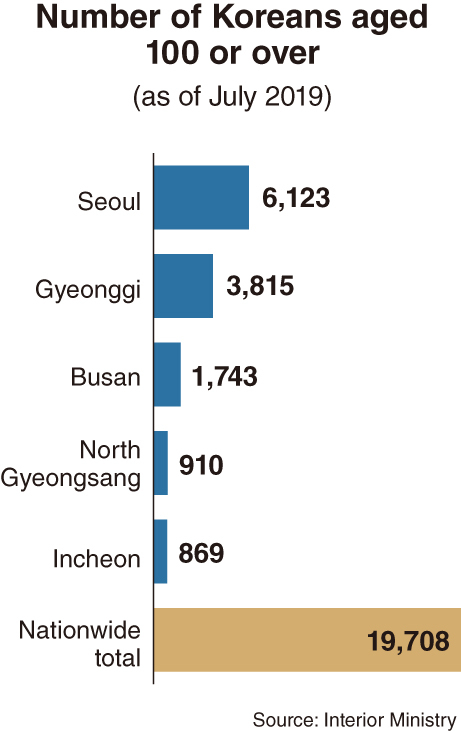[News Focus] More than 10,000 centenarians reside in Seoul metropolitan area
By Kim Yon-sePublished : Aug. 5, 2019 - 16:15
SEJONG -- The population of South Korea increased by less than 1.2 percent over the past five years from 51.25 million in July 2014 to 51.84 million in July 2019, amid the record-low birthrates.
According to the Ministry of Interior and Safety, the number of Koreans increased by only 595,000 over the five-year period. This indicates a growth of less than 10,000 a month on average.
Apart from the rapid reduction of newborns and those aged under 15, the working population aged between 15 and 64 has continued to fall over the past few years.
In contrast, the number of people aged 70 or over is blocking the decrease of the overall population, posting sharp growth rates.
The number of Koreans aged 70 or above recorded 4.37 million in July 2014, accounting for 8.5 percent of then-population.
According to the Ministry of Interior and Safety, the number of Koreans increased by only 595,000 over the five-year period. This indicates a growth of less than 10,000 a month on average.
Apart from the rapid reduction of newborns and those aged under 15, the working population aged between 15 and 64 has continued to fall over the past few years.
In contrast, the number of people aged 70 or over is blocking the decrease of the overall population, posting sharp growth rates.
The number of Koreans aged 70 or above recorded 4.37 million in July 2014, accounting for 8.5 percent of then-population.

The corresponding elderly population reached 5.39 million in July 2019, taking up 10.3 percent of the population.
“The percentage of those in their 70s or over stayed at 6.5 percent 10 years ago (3.26 million),” said a demographic analyst. “The population of seniors surged by one million in five years and two million in a decade.”
Given that the senior population includes those aged 65-69 in Korea following the UN standards, the situation is serious like Japan, whose people aged 70 or over take up more than 20 percent of its population, he said.
By age group, the number of Koreans aged 70-79 came to 3.55 million as of last month, followed by those in the 80-89 age bracket at 1.58 million, those aged 90-99 at 223,000 and centenarians at 19,708.
The figure of 5.39 million for Koreans in their 70 or over surpasses the number of the second-youngest group, aged 10 to 19, which is 5.02 million.
Gyeonggi Province had the largest senior population with 1.09 million, more than 20 percent of the 5.39 million, trailed by Seoul with 971,000, Busan with 398,000, North Gyeongsang Province with 381,000, South Gyeongsang Province with 368,000 and South Jeolla Province with 309,000.
Seoul had the largest population of centenarians aged 100 or above at 6,123, followed by Gyeonggi Province (3,815), Busan (1,743), North Gyeongsang Province (910), Incheon (869), South Chungcheong Province (823), and South Jeolla Province (794). Sejong also had centenarians (57) though the number was the lowest among 17 major cities and provinces.
The statistics shows more than 10,000 centenarians were residing in the Seoul metropolitan region, which involves Gyeonggi Province and Incheon.
The 10,807 individuals of the total 19,708 is roughly in proportion to the percentage of Koreans residing in Seoul, Gyeonggi and Incheon -- one in two of the people across the country. The collective population in the three areas exceeds 25 million.

The number of those in their 100s stood at 14,592 in July 2014 and 2,524 in July 2009.
Suggestions have been vitalized for the aged society. An online commenter said that the government should use taxpayers’ money for the seniors -- particularly for those residing alone -- and the underprivileged in the society, not for the jobless youth.
A commenter claimed the social welfare should be pushed on the back of regular taxes, citing the deletion worries over the national pension. “Premiums for the national pension of salaried workers should not be exploited as taxes,” he said.
The concerns involving national pension is related to the decrease in the working-age population.
Korea’s working population, aged 15-64, peaked at 37.786 million in November 2016.
Since December 2016, that figure has dropped consistently. As of June 2019 it stood at 37.448 million, having declined for the 32nd consecutive month. That amounts to 338,000 fewer people in less than three years.
Statistics Korea forecasts that people aged 15-64 will fall below 70 percent of the population within five years to 69.9 percent in 2024. The state-run agency also predicted that this figure would post less than 60 percent in 2036 and less than 50 percent in 2056.
Further, projections indicate that the senior population will overtake the working-age population, relative to the total population, in 2065, when working-age people will comprise 45.9 percent of the total and seniors 46.1 percent.
By Kim Yon-se (kys@heraldcorp.com)



















![[Today’s K-pop] BTS pop-up event to come to Seoul](http://res.heraldm.com/phpwas/restmb_idxmake.php?idx=642&simg=/content/image/2024/04/17/20240417050734_0.jpg&u=)